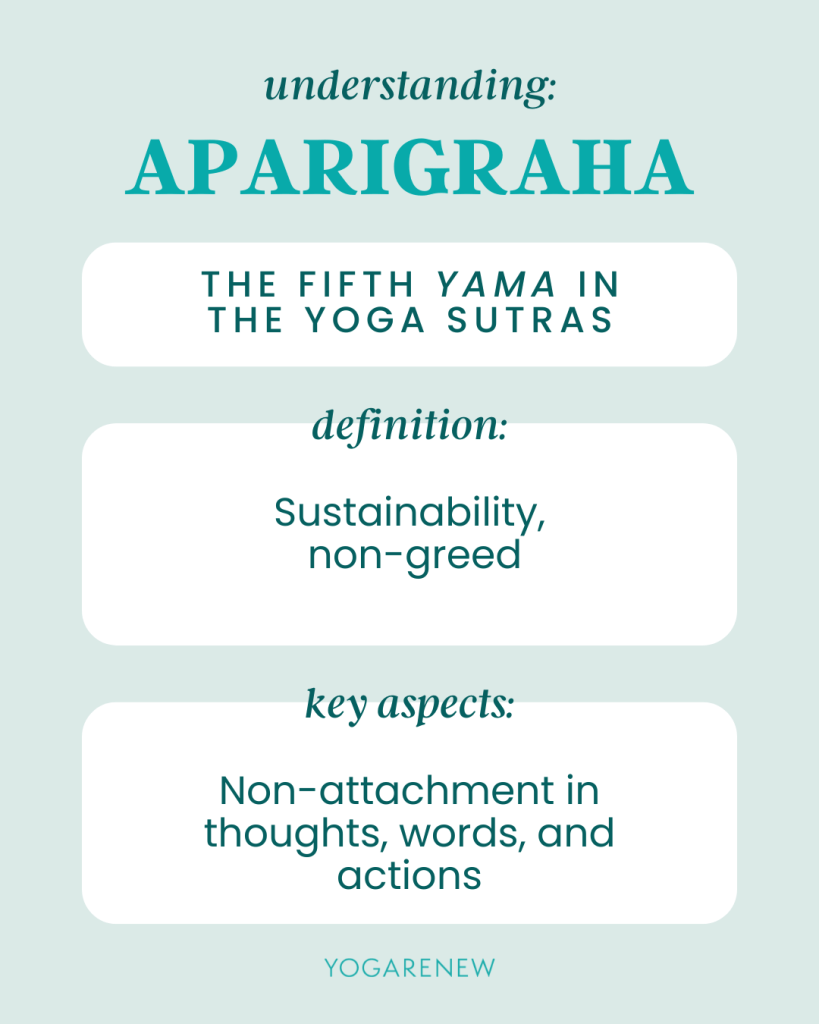
Aparigraha, a cornerstone of yogic philosophy, invites us to live with a sense of non-attachment and simplicity. Derived from Sanskrit, Aparigraha means “non-possessiveness” or “non-grasping,” encouraging us to let go of excessive attachments and desires. In this blog post, we will explore the significance of Aparigraha within yogic practices and how embracing this principle can lead to a more balanced, mindful, and fulfilling life.
Understanding Aparigraha in Yoga
Aparigraha is the fifth and final Yama in the Yoga Sutras of Patanjali, following Ahimsa (non-violence), Satya (truthfulness), Asteya (non-stealing), and Brahmacharya (moderation). It emphasizes the importance of letting go of material possessions, unhealthy attachments, and the constant craving for more. Practicing Aparigraha fosters contentment and helps us cultivate a deeper connection to our true selves.
Aparigraha on the Mat: Physical Practice
In the context of yoga practice, Aparigraha encourages us to approach our physical practice with mindfulness and non-attachment. Here’s how Aparigraha can be applied on the mat:
- Letting Go of Expectations: Release any expectations about achieving specific poses or reaching a certain level of flexibility. Embrace the practice as it is and focus on the journey rather than the destination.
- Non-Comparison: Avoid comparing yourself to others in the class. Each individual’s practice is unique, and Aparigraha invites us to honor our own progress without envy or judgment.
- Mindful Practice: Cultivate a sense of presence and awareness during your practice. Let go of distractions and immerse yourself fully in the experience of each pose.
Aparigraha Beyond the Mat: Daily Life
Aparigraha extends into every aspect of our daily lives, guiding us to live with simplicity and gratitude. Here are some ways to integrate Aparigraha into your daily routine:
- Decluttering: Simplify your living space by letting go of unnecessary possessions. Practice mindful consumption and prioritize experiences over material goods.
- Gratitude: Cultivate a sense of gratitude for what you have. Focus on appreciating the present moment and the abundance in your life rather than constantly seeking more.
- Mindful Relationships: Avoid clinging to relationships out of fear or dependency. Foster healthy, supportive connections that are based on mutual respect and love.
Aparigraha in Relationships
Aparigraha fosters healthy and balanced relationships by encouraging us to approach our interactions with mindfulness and non-attachment. Practicing Aparigraha in relationships involves:
- Healthy Boundaries: Establish and respect personal boundaries. Avoid possessiveness and allow others the freedom to grow and evolve.
- Generosity: Practice generosity and selflessness in your relationships. Focus on giving rather than taking, and support others without expecting anything in return.
- Non-Clinging: Let go of the need to control or possess others. Embrace the natural flow of relationships and trust in the process.
Aparigraha and Inner Peace
Embracing Aparigraha cultivates inner peace by freeing us from the burden of excessive attachments and desires. By letting go of what no longer serves us, we create space for contentment, clarity, and self-discovery. This inner simplicity allows us to live more freely and joyfully, aligned with our true purpose.
Conclusion: The Journey of Aparigraha
Incorporating Aparigraha into our yogic practice and daily lives is a continuous journey of self-awareness and growth. It challenges us to live with simplicity, gratitude, and non-attachment, fostering deeper connections with ourselves and others. As we embrace Aparigraha, we align more closely with the true essence of yoga—unity, harmony, and inner peace.
By living with a mindset of non-attachment and simplicity, we create a ripple effect of mindfulness and well-being in the world, inspiring others to join us on this transformative path. Let Aparigraha guide you both on and off the mat, nurturing a life of integrity, connection, and inner tranquility.
Continue Reading...
Take a Journey Through the Yamas/Niyamas
Enhance your spiritual journey with incredible insight on the Yamas/Niyamas in Julie Pasqual’s immersive and transformative online course. Get started for free, and gain access to YogaRenew’s Ether app with all of our workshops, classes, series and live events.






